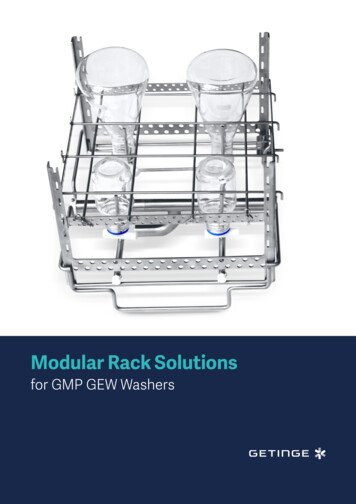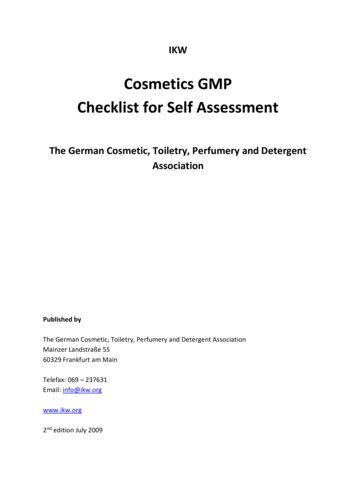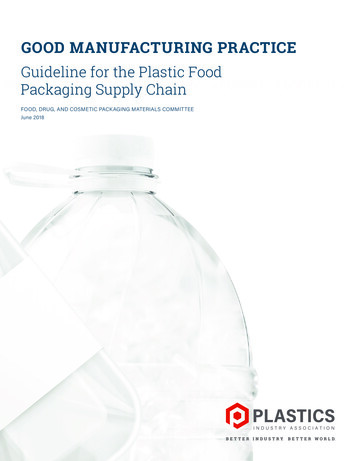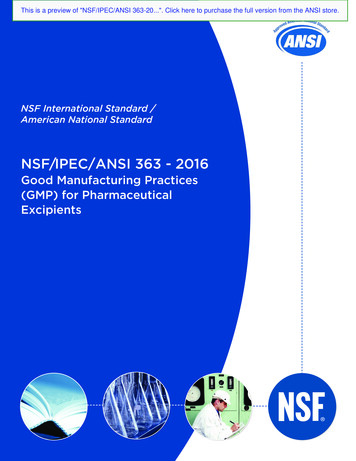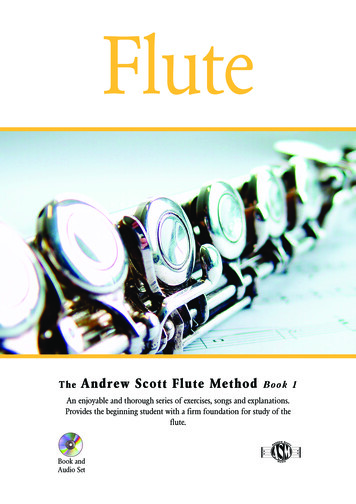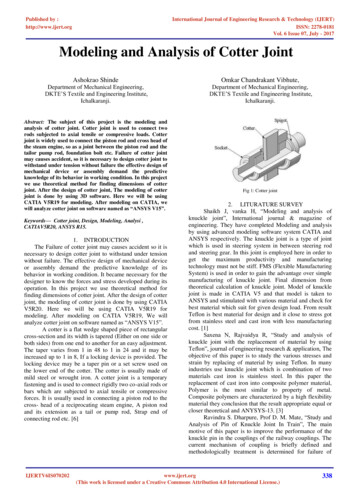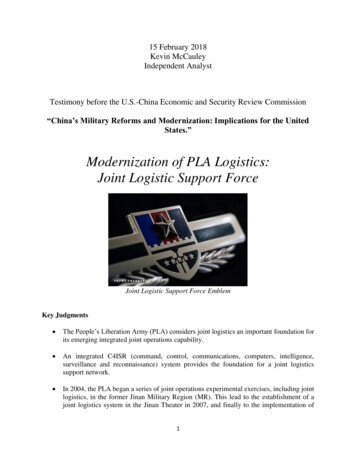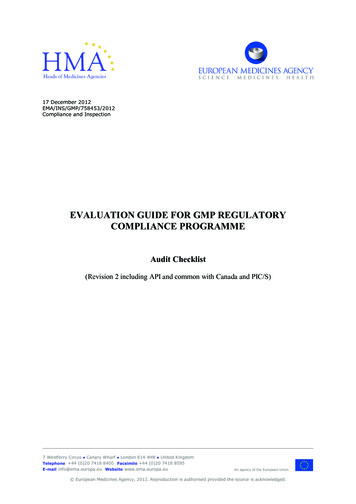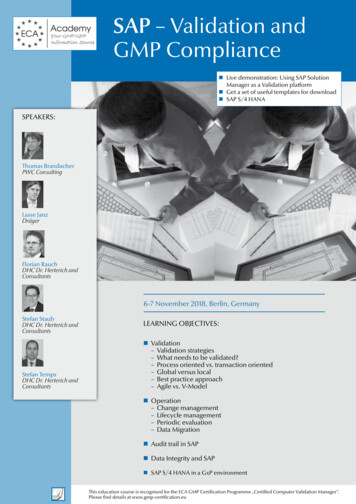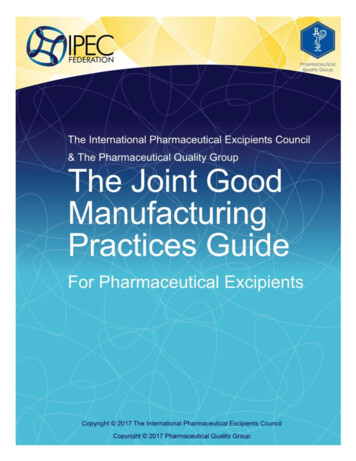
Transcription
Page 1
This document represents voluntary guidance for the excipient industry and the contentsshould not be interpreted as regulatory requirements. Alternatives to the approaches inthis Guide may be used to achieve an equivalent level of assurance for excipient quality.FOREWORDIPECThe IPEC Federation is a global organization that promotes quality in pharmaceutical excipients andrepresents the five existing regional International Pharmaceutical Excipient Councils - IPEC-Americas,IPEC China, IPEC Europe, IPEC Japan, and IPEC India - and provides a unified voice to promote thebest use of excipients in medicines as a means of improving patient treatment and safety.IPEC has three major stakeholder groups:1. Excipient manufacturers and distributors, who are considered suppliers in this document.2. Pharmaceutical manufacturers, who are called users.3. Regulatory authorities who regulate QGCopyright 2017 The International Pharmaceutical Excipients Council andCopyright 2017 Pharmaceutical Quality GroupPage 2
The PQG was formed in 1977 to promote development of a consistent approach to pharmaceuticalquality and good manufacturing practice. The group has since expanded, and in 1990 the PQG publishedthree codes of practice to cover pharmaceutical raw materials, printed and contact packaging materials. In1995 the codes were revised and were integrated with ISO 9002:1994. The code for raw materials wasrevised and reissued as PS 9100:2002 Pharmaceutical excipients, an application standard and GMP guidefor pharmaceutical excipients.For further information, see www.pqg.orgThis document offers best practice and guidance on the content of an excipient Good ManufacturingPractices Guide. It is important that the reader confirms this is the latest version of the guide as found onthe appropriate website at ipec.org or pqg.orgCopyright 2017 The International Pharmaceutical Excipients Council andCopyright 2017 Pharmaceutical Quality GroupPage 3
TABLE OF CONTENTSFOREWORD. 2ACKNOWLEDGEMENTS . 71INTRODUCTION . 81.1 Purpose and Scope . 81.2 Principles Adopted . 81.2.1 The Guide and its Use . 81.2.2 Application . 91.2.3 Quality System Standard . 91.3 Document Structure. 92DEFINITIONS . 933.13.2GENERAL GUIDANCE . 10Excipients . 10Excipient GMP Implementation . 104QUALITY MANAGEMENT SYSTEM- EXCIPIENT QUALITY SYSTEMS . 104.1 General Requirements . 104.2 Documentation Requirements . 114.2.1 General . 114.2.2 Quality Manual. 114.2.3 Control of Documents . 114.2.4 Control of Records . 124.3 Change Control. 125MANAGEMENT RESPONSIBILITY . 135.1 Management Commitment . 135.2 Customer Focus . 135.3 Quality Policy . 135.4 Planning . 145.4.1 Quality Objectives . 145.4.2 Quality Management System Planning . 145.5 Responsibility, Authority and Communication . 145.5.1 Responsibility and Authority . 145.5.2 Management Representative . 155.5.3 Internal Communication . 155.6 Management Review . 155.6.1 General . 155.6.2 Review Input . 155.6.3 Review Output. 156RESOURCE MANAGEMENT . 166.1 Provision of Resources . 166.2 Human Resources . 166.2.1 General . 166.2.2 Competence, Awareness and Training . 166.2.3 Personnel Hygiene. 16Copyright 2017 The International Pharmaceutical Excipients Council andCopyright 2017 Pharmaceutical Quality GroupPage 4
6.3 Infrastructure . 176.3.1 Buildings and Facilities . 176.3.2 Equipment . 176.3.2.1 Equipment Construction . 186.3.2.2 Equipment Maintenance . 186.3.2.3 Computer Systems. 186.3.3 Utilities . 186.3.4 Water . 196.4 Work Environment . 196.4.1 Air Handling. 196.4.2 Controlled Environment . 206.4.3 Cleaning and Sanitary Conditions . 206.4.4 Pest Control . 206.4.5 Lighting . 206.4.6 Drainage . 216.4.7 Washing and Toilet Facilities . 217PRODUCT REALISATION . 217.1 Planning of Product Realisation . 217.2 Customer-related Processes . 217.2.1 Determination of Requirements Related to the Product . 217.2.2 Review of Requirements Related to the Product . 227.2.3 Customer Communication . 227.3 Design and Development . 227.4 Purchasing . 237.4.1 Purchasing Process . 237.4.2 Purchasing Information . 237.4.3 Verification of Purchased Product . 237.5 Production and Service Provision . 247.5.1 Control of Production and Service Provision. 247.5.1.1 Production Instructions and Records . 247.5.1.2 Equipment Cleaning . 257.5.1.3 Recovery of Solvents, Mother Liquors and Second Crop Crystallisations . 257.5.1.4 In-process Blending or Mixing . 257.5.1.5 In-process Control . 267.5.1.6 Packaging and Labelling . 267.5.1.7 Records of Equipment Use. 277.5.2 Validation of Processes for Production and Service Provision . 277.5.3 Identification and Traceability . 277.5.3.1 Traceability . 277.5.3.2 Inspection and Test Status. 287.5.3.3 Labelling . 287.5.4 Customer Property. 287.5.5 Preservation of Product . 287.5.5.1 Handling, Storage and Preservation . 287.5.5.2 Packaging Systems . 287.5.5.3 Delivery and Distribution. 297.6 Control of Measuring and Monitoring Devices . 29Copyright 2017 The International Pharmaceutical Excipients Council andCopyright 2017 Pharmaceutical Quality GroupPage 5
8MEASUREMENT, ANALYSIS AND IMPROVEMENT . 308.1 General . 308.2 Monitoring and Measurement . 308.2.1 Customer Satisfaction . 308.2.2 Internal Audit . 308.2.3 Monitoring and Measurement of Processes . 308.2.4 Monitoring and Measurement of Product . 318.2.4.1 Laboratory Controls . 318.2.4.2 Finished Excipient Testing and Release . 328.2.4.3 Out-of-Specification Test Results . 328.2.4.4 Retained Samples . 338.2.4.5 Certificates of Analysis . 338.2.4.6 Impurities . 338.2.4.7 Stability . 348.2.4.8 Expiry/Re-evaluation Periods . 348.3 Control of Nonconforming Product . 348.3.1 Reprocessing . 348.3.2 Reworking . 348.3.3 Returned Excipients . 358.4 Analysis of Data . 358.5 Improvement. 358.5.1 Continual Improvement . 358.5.2 Corrective Action . 368.5.3 Preventive Action . 36APPENDIX AAUDITING CONSIDERATIONS . 37A1. Introduction . 37A2. GMP Principles . 37A2.1 Control of impurities and contamination . 37A2.2 Excipient properties and functionality . 37A2.3 Consistency of manufacture and change control . 38A2.4 Traceability . 38A3. Application of GMP Principles . 38A4. General Auditing Considerations . 38A5. Audit Check Points. 39A6. Documentation and Record Review . 40Copyright 2017 The International Pharmaceutical Excipients Council andCopyright 2017 Pharmaceutical Quality GroupPage 6
ACKNOWLEDGEMENTSThis Guide was developed by representatives of the members companies of The InternationalPharmaceutical Excipients Council Federation (IPEC) and the Pharmaceutical Quality Group (PQG).IPEC and PQG greatly appreciate the many hours devoted by the core team of individuals and othercontributors listed below, to make this Guide available to IPEC members and the broader excipientcommunity. Equally, IPEC and PQG extend their thanks to the employers of those same contributors whoprovide the necessary time and resources, without which, this Guide would not be possible.CORE REVISION TEAMIPECLars Albermann, MerckWiebke Baehker, MerckMarta Cabrera, CrodaFrederik De Vos, Janssen PharmaceuticaRainer Fendt, BASFAlbin Lannoy, Roquette FreresRoberto Mastrantonio, Eli LillyKevin McGlue, ColorconAndreas Pfrengle, GraceAstrid Stockrahm-Uhling, DFE PharmaBeverley Stout, GlaxoSmithKlinePQGIan McKeown, PQ SilicasStephen Moss, GlaxoSmithKlineCopyright 2017 The International Pharmaceutical Excipients Council andCopyright 2017 Pharmaceutical Quality GroupPage 7
JOINT IPEC – PQG GOOD MANUFACTURINGPRACTICE GUIDE FOR EXCIPIENTS 20171 INTRODUCTION1.1 Purpose and ScopeThe quality of excipients is critical to assure the safety, quality and efficacy of medicines.Excipients have a wide range of applications and are essential components of the drug productformulation. Characteristics that excipients impart to formulated drug products include cosmeticappearance, stability and delivery of the active ingredient. Therefore, applying appropriate GoodManufacturing Practice (GMP) principles to excipients is essential. There are a large number ofapplications for this diverse range of materials which makes the development of excipient GMPguidelines challenging.Increasingly users of excipients are required by regulatory authorities to assure patient safetythrough the evaluation of risks and application of suitable GMP to the manufacture and supply ofeach excipient. This document proposes GMP appropriate for the manufacture of excipients andis a joint initiative between the International Pharmaceutical Excipients Council (IPEC), and thePharmaceutical Quality Group (PQG). It was first published in 2006 incorporating the IPECGood Manufacturing Practices Guide for Bulk Pharmaceutical Excipients 2001 with the PQG’sPS 9100:2002 Pharmaceutical Excipients.This document is applicable to the manufacture of excipients intended for use in drug products. Itcovers the quality management system and the extent of GMP necessary throughoutmanufacturing for both batch and continuous processes. Reference is made to other publicationsand standards, such as the EXCiPACT GMP and GDP or NSF/IPEC/ANSI-363 2014 standards.The manufacture of certain excipients for specialist applications presents additional challengesthat are outside of the scope of this Guide. Examples include excipients; for parenteral, ocular, inhalation, open wound use, that are sterile and/or pyrogen free.In these cases, it is recommended that guidelines and compliance programmes that providedetailed guidance for the manufacture of the related drug products be consulted and adapted asnecessary to the excipient in question.For additional guidance relating to Good Distribution Practices (GDP) refer to the IPEC GoodDistribution Practices Guide.1.2 Principles Adopted1.2.1The Guide and its UseExcipients are diverse and often have uses other than for pharmaceutical applications.Each manufacturer should consider how this Guide might apply to their products andprocesses (for example batch versus continuous processes). Since excipients are sodiverse, some principles of this Guide may not be applicable to certain products andmanufacturing processes.Copyright 2017 The International Pharmaceutical Excipients Council andCopyright 2017 Pharmaceutical Quality GroupPage 8
For the purposes of this Guide the terms GMP and current Good Manufacturing Practice(cGMP) are equivalent.The term “should” indicates recommendations that are expected to apply unless shown tobe inapplicable or replaced by an alternative that provides at least an equivalent level ofquality assurance. Note that “should” does not mean “must” or “shall”.1.2.2ApplicationThe text provides the guidance necessary for the manufacture of excipients, but not all ofthe details. As an international guidance document, it cannot specify national legalrequirements or cover particular characteristics of every excipient.1.2.3Quality System StandardThe quality management system standard chosen as a framework for this Guide is ISO9001, which is appropriate for manufacturing facilities. A manufacturer may apply theISO standard with or without certification, but this is a business decision and not arecommendation of this Guide. However, ISO certification has the benefit of providingassurance to customers that the excipient manufacturer’s quality management system hasbeen independently verified.IPEC and the PQG believe that merging GMP principles for excipient manufacturinginto the ISO 9001 quality management system enhances not only quality management butalso an organization’s operational procedures. The organization may also seekcertification to an excipient GMP standard such as EXCiPACT.1.3 LayoutThe headings in this document have been aligned with the ISO 9001:2008 clause numbers,because many excipient manufacturers already use the ISO 9001 standard as a basis for theirquality management system. Additional headings are included as required to introduce theadditional guidance on GMP when not covered by ISO 9001 clauses. A further revision of thisGuide to ISO 9001:2015 clause structure is in preparation.Section 3 General Guidance provides an overview of the GMP criteria applicable to excipientmanufacture and the point of application of excipient GMP.Sections 4 to 8 give guidance on the GMP principles and implementation of a qualitymanagement system suitable for excipient manufacture. No attempt has been made to includedetails specific to particular excipients. Individual manufacturers should address these as theyapply to their own products and processes.Appendix A covers excipient GMP Auditing Considerations, which describe key criteria to beconsidered when auditing an excipient manufacturing facility.2 DEFINITIONSRefer to the International Pharmaceutical Excipient Council Glossary: General Glossary of Termsand Acronyms.Copyright 2017 The International Pharmaceutical Excipients Council andCopyright 2017 Pharmaceutical Quality GroupPage 9
3 GENERAL GUIDANCEInternational regulations governing drug products require that they be produced, processed,packed and stored in accordance with GMP. Unlike pharmaceutical products and APIs, there waspreviously little guidance specifically addressing excipients manufacture.3.1 ExcipientsExcipients are substances other than the API, which have been appropriately evaluated for safetyand are intentionally included in a drug delivery system.For example, excipients can: aid in the processing of the drug delivery system during its manufacture, protect, support or enhance stability, bioavailability or patient acceptability, assist in product identification, enhance any other attribute of the overall safety, effectiveness or delivery of the drugproduct during storage or use.3.2 Excipient GMP ImplementationThe application of GMP is relevant once it has been determined that a chemical is intended foruse as a component of a drug product. Excipient manufacture should be carried out in accordancewith the GMP concepts consistent with this Guide. The objective of excipient GMP is to ensurethat the manufacture of an excipient results in a consistent material with the desired qualitycharacteristics. The emphasis of GMP for excipients is to assure product integrity, avoid productcontamination and ensure that records are maintained.Manufacturing processes should be controlled and documented, and at some logical processingstep, as determined by the manufacturer, GMP practices as described in this Guide should beapplied and maintained. As the excipient manufacturing process progresses, the degree ofassurance concerning the quality of the product should increase.Justification based on a documented risk assessment and a thorough knowledge of the process isrequired to determine the point at which GMP should be applied. This is usually well before thefinal finishing operation and for example may be identified using methods such as HACCP(Hazard Analysis and Critical Control Point), FMEA (Failure Mode and Effects Analysis) or adetailed process flow diagram. Consideration should also be given to other factors such as batchversus continuous processing, dedicated versus multi-purpose equipment, open versus closedprocesses (see also Appendix A for further examples).4 QUALITY MANAGEMENT SYSTEM - EXCIPIENT QUALITY SYSTEMS4.1 General RequirementsThe principles outlined in this Guide provide a comprehensive basis for the quality managementsystem used in the manufacture of excipients. Excipient manufacturers should identify andimplement the quality management processes required to assure excipient quality accounting forlegal, technological, cultural and social environments. The elements of the quality managementprocesses should be applied in a manner that is appropriate and proportionate to each of theproduct lifecycle stages, recognizing the different goals and knowledge available at each stage.Copyright 2017 The International Pharmaceutical Excipients Council andCopyright 2017 Pharmaceutical Quality GroupPage 10
Where manufacturing, testing or other operations that could affect excipient quality areoutsourced, this should be communicated to the customer (see also 7.2.3). The responsibility forquality remains with the excipient manufacturer and control measures should be defined (see also7.4.2).4.2 Documentation Requirements4.2.1GeneralThe excipient manufacturer should have a system in place to control documents and datathat relates to the requirements of the quality management system. The organization’soverall intentions and approach to GMP should be described and documented tofacilitate common understanding and consistent application.4.2.2Quality ManualThe excipient manufacturer should have a documented description of the qualitymanagement system, the quality policy and the commitment of the organization toapplying the appropriate GMP and quality management standards contained in thisGuide. This document should include the scope of the quality management system,reference to supporting procedures and a description
Copyright 2017 The International Pharmaceutical Excipients Council and Copyright 2017 Pharmaceutical Quality Group Page 3 The PQG was formed in 1977 to promote .
